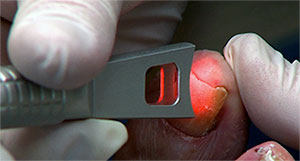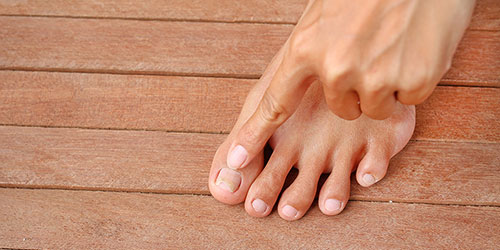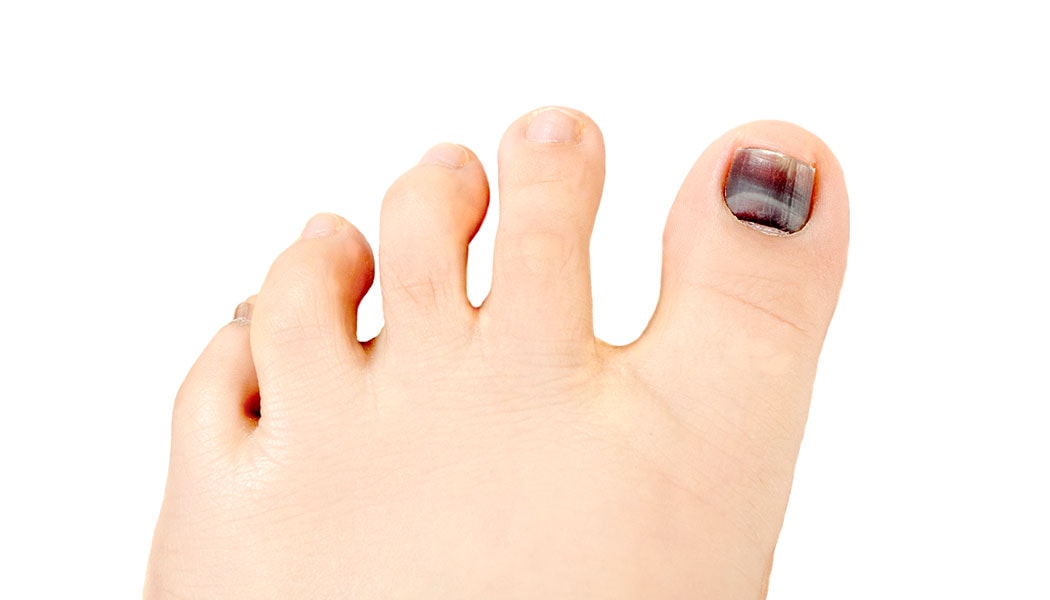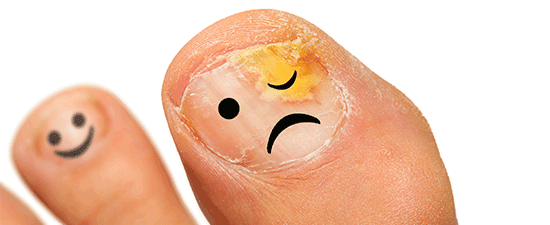- Home
- Foot & Ankle Conditions
- Toenails Conditions
- Toenail Fungus
Toenail Fungus: causes, symptoms and treatment

What's Toenail Fungus?
Fungal infections of the nail plate (also known as onychomycosis) are the most common nail disease.
Various types of fungi are present everywhere in the environment, and most are harmless until they penetrate the skin.
A fungus can invade through minor cuts or after injury. Repeated irritation to the toes may cause the nail to separate from the bed, making the toes vulnerable.
- What are the symptoms of toenail fungus?
- What causes toenail fungal infections?
- What are fungal toenail treatment options?
- How to prevent toenail fungus
- Other types of nail infections
- University Foot and Ankle Institute, the Best Choice for Onychomycosis Treatment
- Frequently Asked Questions about Toenail Fungus
- How effective is laser treatment compared to taking meds to kill the toenail fungus? And which helps prevent re-occurrences better?
- How effective are laser devices for nail fungus treatment?
- How effective are topical antifungal creams in the treatment of onychomycosis?
- How long does it take for the new nail to grow following a laser treatment session?
- Is laser treatment for toenail fungus covered by insurance?
- What's a mycotic nail?
-
Foot and Ankle Surgeon at University Foot and Ankle Institute
Dr. Justin Franson, DPM, is a Board Certified Podiatric Foot and Ankle Specialist and Diplomate of the American Board of Podiatric Surgery. He attended the School College of Podiatric Medicine in Chicago, graduating in 2001. Dr. Franson then accepted a three-year residency program at the Greater Los Angeles VA and UCLA County Hospital.
Dr. Franson specializes in several areas including total ankle replacement and sports medicine. Treating athletes and weekend warriors like himself brings him a lot of joy. Dr. Franson keeps active with running marathons, triathlons, hiking, basketball, and golf.
Learn More from our Toenail Fungus Blog Articles
- Couples Living Together Share a Lot of Things, Even the Bacteria on Their Feet
- Can a Blow Dryer Prevent Toenail Fungus?
- Paronychia: Treating and Avoiding Annoying Nail Infections
- What Causes a Black Toenail? Should You Be Worried?
- Treating Athlete’s Foot with Garlic? Prepare to Be Burned, Literally!
- What To Do When Your Toenail Is Falling Off
 I felt very comfortable and they are so nice that you feel right at home, that's why I keep coming back.Edna R.
I felt very comfortable and they are so nice that you feel right at home, that's why I keep coming back.Edna R. Dr. Franson was referred to us for my husband ankle. Everything went so smooth and easy. Dealing with the VA seemed that it was...Italivi C.
Dr. Franson was referred to us for my husband ankle. Everything went so smooth and easy. Dealing with the VA seemed that it was...Italivi C. Overall, it was a great experience. I've been coming to Dr. Kellman for about a year and he and his staff are very helpful.Vanessa W.
Overall, it was a great experience. I've been coming to Dr. Kellman for about a year and he and his staff are very helpful.Vanessa W. ExcellentDebasish M.
ExcellentDebasish M. Everyone was friendly and professional.Victor L.
Everyone was friendly and professional.Victor L. Very efficient and an excellent serviceHorwitz J.
Very efficient and an excellent serviceHorwitz J. Dr. Johnson was so kind, thorough and patient. Now I have a much better understanding of my “ crazy toes” and what my options a...Tracy S.
Dr. Johnson was so kind, thorough and patient. Now I have a much better understanding of my “ crazy toes” and what my options a...Tracy S. Chaos in the office checkin. We weren’t forewarned about the iPad data collection. That made me late for a following appointmen...Carl C.
Chaos in the office checkin. We weren’t forewarned about the iPad data collection. That made me late for a following appointmen...Carl C. Dr Nalbandian is an exceptional doctor and person. The staff respectfully & compently delt with an issue I had regarding a prev...Karen M.
Dr Nalbandian is an exceptional doctor and person. The staff respectfully & compently delt with an issue I had regarding a prev...Karen M. Visiting the office is a pleasurable occurance.Thomas J.
Visiting the office is a pleasurable occurance.Thomas J. Dr Kelman and his staff are always wonderfully caring and respectful to my father who has Alzheimer's dementia.Erland E.
Dr Kelman and his staff are always wonderfully caring and respectful to my father who has Alzheimer's dementia.Erland E. Thank you for being there for your patients.Dieter B.
Thank you for being there for your patients.Dieter B.
-
 Listen Now
Couples Living Together Share a Lot of Things, Even the Bacteria on Their Feet
Read More
Listen Now
Couples Living Together Share a Lot of Things, Even the Bacteria on Their Feet
Read More
-
 Listen Now
Can a Blow Dryer Prevent Toenail Fungus?
Read More
Listen Now
Can a Blow Dryer Prevent Toenail Fungus?
Read More
-
 Listen Now
Paronychia: Treating and Avoiding Annoying Nail Infections
Read More
Listen Now
Paronychia: Treating and Avoiding Annoying Nail Infections
Read More
-
 Listen Now
What Causes a Black Toenail? Should You Be Worried?
Read More
Listen Now
What Causes a Black Toenail? Should You Be Worried?
Read More
-
 Treating Athlete’s Foot with Garlic? Prepare to Be Burned, Literally!
Read More
Treating Athlete’s Foot with Garlic? Prepare to Be Burned, Literally!
Read More
-
 Listen Now
What To Do When Your Toenail Is Falling Off
Read More
Listen Now
What To Do When Your Toenail Is Falling Off
Read More








